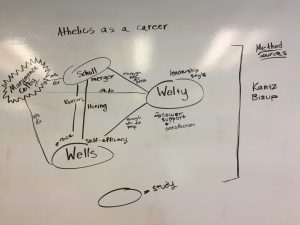In class today I created this depiction of source interactions (pictured below). I had just done a similar thing with my words as I wrote the first first sentences literature review on these sources. However, the image was a much better way of seeing the interactions  between the sources, without having to stumbling over wording. As I was writing the literature review I would get stuck on trying to articulate what I meant. Essentially, making a diagram is a more natural way for me to connect sources because I don’t get sidetracked trying to find how to say what I am trying to say. For example, I loved how I could incorporate method sources (as defined in previous articles). With creating a visual depiction I can remind myself to incorporate different aspects of articles without.
between the sources, without having to stumbling over wording. As I was writing the literature review I would get stuck on trying to articulate what I meant. Essentially, making a diagram is a more natural way for me to connect sources because I don’t get sidetracked trying to find how to say what I am trying to say. For example, I loved how I could incorporate method sources (as defined in previous articles). With creating a visual depiction I can remind myself to incorporate different aspects of articles without.
You might be thinking: “It looks a little messy”
Obviously, this map is scattered and a first draft of the connections. So when I have more sources I hope to create a more organized, clear diagram (I will make a blog post to that when I create it). The link will appear here when I have posted it.
You might be thinking: “That’s so much work though”
Now it may seem like a lot of work to create a visual representation in addition to actually writing and researching for the essay, but this process is more comfortable for me. Rather than jumping into writing the literature view and just winging it, then having to go back and edit extensively, I can go into my writing with an idea of where I am headed.
You might be thinking: “This diagram is overwhelming”
The only drawback that I see is there is that this web style of connections creates a complexity which does not allow for easy reading. I hope that when I create my second diagram I will have a better understanding of which connections are most important to my approach to the subject so that I can simplify the diagram and make it easier for the casual observer to understand. Yes, this diagram is for me, but I will also benefit from the simplification because it will force me to identify which parts of the sources to focus in on.
Stay tuned for the bigger, better version two!
